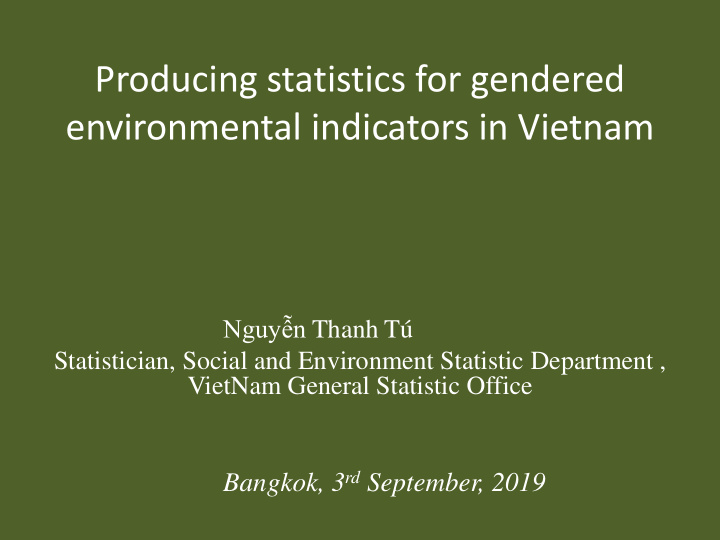



Producing statistics for gendered environmental indicators in Vietnam Nguyễn Thanh Tú Statistician, Social and Environment Statistic Department , VietNam General Statistic Office Bangkok, 3 rd September, 2019
The road map of the environment data General Statistic Office Ministries Provinces Statistic Office Department in provinces District Statistic Office Commune Statistic staff
The road map of the gender data General Statistic Office Ministry of Labor, War invalids and Social Affairs (Gender equality department) Ministries International University, organizations: Institute, UNFPA, WB, research center UNWOMEN, UNESCAP, EmPower …
The environment indicators • National Statistical Indicator System (NSIS): 8 indicators in the environment protection group: 1. Current forest area 2. Protected forest area 3. Forest cover 4. Number of natural hazard events and level of injury 5. Coverage proportion of nature reserves 6. Area of degraded land 7. Proportion of hazardous wastes which have been treated 8. Greenhouse gas emissions per capita
The environment protection indicators in NSIS • They have been standardized on the concept, content, calculation method, major decentralization and data source. • All indicators have data, high reliability. But there is only 1 indicator disaggregated by sex: “Number of natural hazard events and level of injury”
The environment indicators Statistical Indicator System of Ministry of Natural resources and Environment: 84 indicators divided into 14 groups, in which has 8 groups are related to Natural resources and Environment: (1) Land, (2) Water resource, (3) Mineral resources and geology, (4) Environment, (5) Hydro-meteorology and Climate change, (6) Measurement, maps and geological information, (7) Marine and island, (8) Explore.
CURRENT SITUATION OF GENDER STATISTICS The Minister of Planning and Investment signed the circular specifies the national gender development indicator set (No. 10/2019 / TT- BKHĐ, July 30, 2019). It has 78 indicators related to the following areas: Population and demographics (12 indicators), Labor, employment and access to resources (22 indicators), Leadership-Management (11 indicators), Education and training (11 indicators), Health and related services (13 indicators), Gender-based violence and social safety (9 indicators)
CURRENT SITUATION OF GENDER STATISTICS In particular, the National gender statistics indicators system is a tool for collecting gender data to monitor and assess gender development, women's progress and gender equality in the areas of economic life, society, meeting the needs of gender statistics information of the Vietnamese government and other organizations and individuals .
CURRENT SITUATION OF GENDERED ENVIRONMENTAL DATA At present, gender statistics in the environment data is: - Missing; - Not synchronized; - Reliability is not high; - Time of collecting and synthesizing data is still prolonged; And: It has not been collected into the system, many data are not official and not concentrated in one agency, ministry or sector.
Climate change statistic indicators system - Finish building the Climate change statistic indicators system last year base on DPSIR model (Driving forces, Pressures, State of the Environment, Impacts, Response) - Finish building the metadata last month.
Climate change statistic indicators system 158 indicators: Driving forces: 25 indicators, Pressures: 18 indicators, State of the Environment: 13 indicators, Impacts: 46 indicators, Response: 56 indicators. 24 indicators are disaggregated by sex.
Recommendations 1. Need an accurate assessment of the current status of gender statistics in environment specifically in climate change and risk reduction in Vietnam. 2. Develop mechanisms and policies to coordinate and share information between ministries and departments should be more timely and transparent.
Recommendations 3. Training on climate change statistics for directly related agencies. Therefore, it is necessary to develop a system of indicators of climate change statistics with special attention to disaggregated indicators. 4. Improve the quality of gender statistics in climate change. Ensuring the timeliness, transparency, objectivity and comparability of data.
Recommendations 5. The awareness of ministries and agencies when compiling gender-related norms is very important. Since there are many surveys related to gender data, the selection and selection of targets should carefully consider the legitimacy of the survey and the standardization of the criteria. 6. Training on micro-analysis and processing of gender statistics surveys at central and provincial levels.
Recommendations 8. Training on gender statistics and the new national gender development statistics set for ministries, branches and localities. 9. Formulating and completing forms of input information collection for the compilation and publication of the national gender development statistics index.
Recommendations 10. Conditions of support from international organizations to better implement gender statistics, climate change statistics, especially gender- disaggregated indicators are extremely important in current conditions. Now in relevant agencies: technical support to improve the capacity of those who directly conduct gender statistics in climate change, financial support ...
Recommend
More recommend